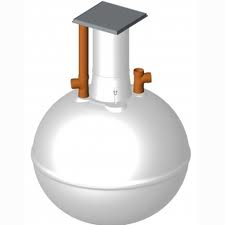Septic Tanks
All septic tank systems consist of the septic tank and a soakaway drainage field. They are not allowed to discharge to ditches, streams or rivers.
Raw sewage enters the tank, solids sink to the bottom, septic effluent leaves the tank and enters the drainfield (soakaway) where naturally occurring bacteria in the top aerobic zone of the soil perform secondary treatment and kill a lot of the pathenonic bacteria. All septic tank outlets should have permit to discharge granted by the EA/SEPA. Septic tanks are:
- Cheaper to buy than sewage treatment plants but the need for a soakaway in addition makes them a more expensive system to install.
- MUST outlet to a drainfield NOT a watercourse
- Drainfields are very expensive to install
- They do not treat sewage - 70% of the original pollutants are still in the effluent, including E.Coli, Hepatitis, etc.
- Do not require power unless a pumped outlet is required to lift the septic effluent
- New installs MUST have EN12566 - Part 1 Certification to be legal in the UK
- Require Permit to Discharge from the EA
- Two main types, brick or concrete tanks (usually 2 chambers) or newer plastic ones - either 'onion' tanks or low profile 2 chamber tanks
- Bacteria in the tank are anerobic and do not require oxygen
- 95% of material entering the tank exits the tank, just the solids are settled; the liquid passes through
- Require emptying annually
- Only allowed for up to 15 persons
It is essential that septic tanks are properly maintained if they are to work properly. They require emptying at least once a year and checking for leaks, cracks, etc. Failure to do this leads to blocked soakaways, flooded soakaways and a system that suddenly does not work anymore.
Commercially manufactured septic tanks are usually made from GRP or HDPE plastic.
